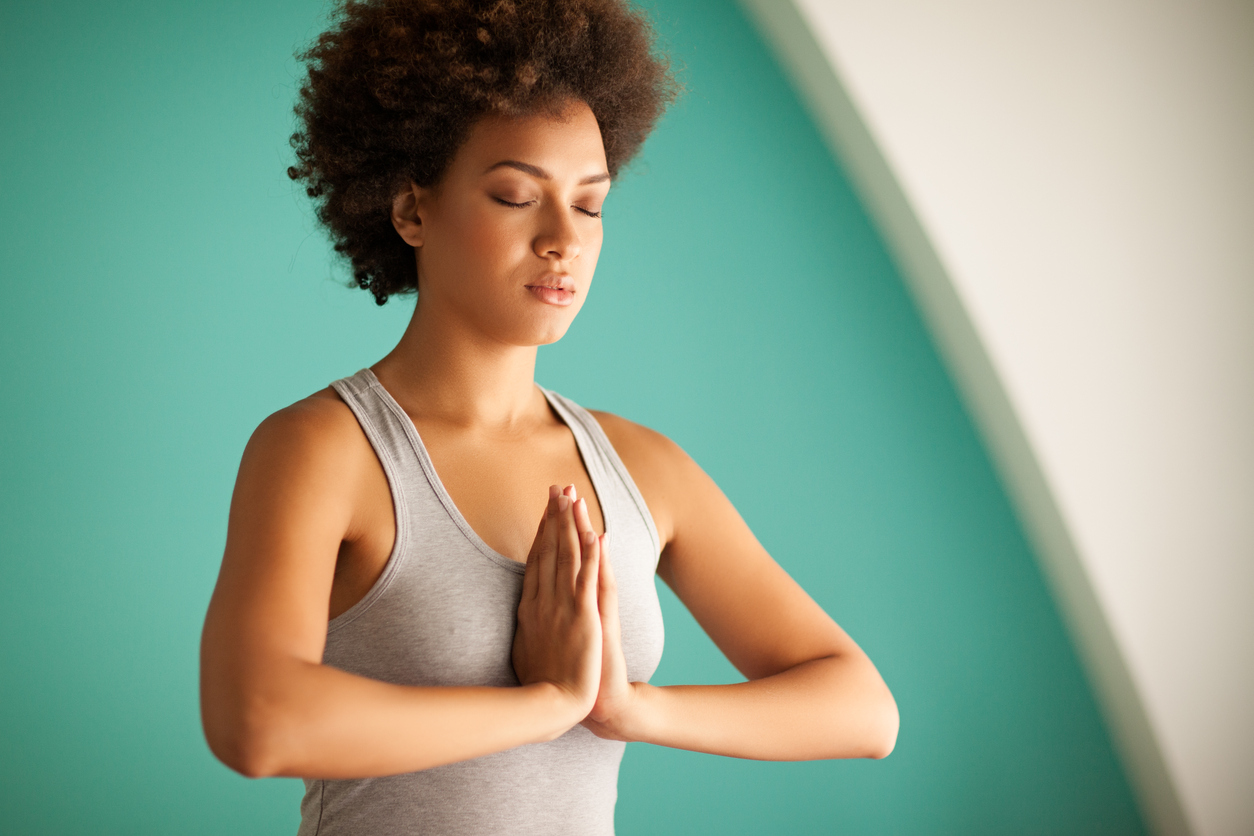Close your eyes; inhale and take a deep exhale. Wonderful; now watch your endless thoughts, important and unimportant, pass before your eyes without letting them control you. Focus only on your deep breathing and stay absolutely still. Difficult, right? Naturally, your mind will become distracted and your thoughts will stray. Trying to meditate is a practice that incorporates mindfulness and awareness of a particular focal point, such as the breath, to transition into a calm state of mind.
Tips To Meditate As A Beginnger
 Although it might be challenging at first, meditation becomes easier and easier with practice and there are a few ways that can make the beginning of your practice easier. Let’s get right into it!
Although it might be challenging at first, meditation becomes easier and easier with practice and there are a few ways that can make the beginning of your practice easier. Let’s get right into it!
1. Reserve A Quiet Space For Your Practice
As a beginner practicing meditation, distractions can definitely get in the way. Your goal should be to settle down somewhere with the least amount of external interference. Find a space in your house with the least amount of distractions and if you live with other people, let them know when you will be practicing to avoid other sudden interruptions. I suggest decorating your meditation area with candles, a meditation cushion, perhaps a yoga mat and whatever else you may need to feel comfortable and relaxed. It might be helpful to avoid your bedroom, office or anywhere that may trigger sleepiness or stress. Try to find a brand new space, even if it’s just a different part of a room, to set up your meditation haven.
2. Listen To Guided Audios
Sitting in complete silence at first can be… unsettling. We are always surrounded by auditory and visual stimulations which can make it difficult to accept the simplicity of silence. Think about how much you multitask; do you play games on your phone or text while watching a TV show? Do you doodle on a notepad while talking on the phone? Do you browse through your emails while listening to your favorite podcast? Our minds are conditioned to receive multiple stimulations at once which makes it very challenging to focus on just one thing at a time, thus, leading to challenges when trying to slow down and meditate. To alleviate your struggles, try exploring the wonderful world of guided audios which can be found on Spotify, YouTube and many other places online for free. Many guided meditation audios consist of a calming voice walking you through the process of slowing down your thoughts, witnessing your thoughts passing by passively, focusing entirely on your breath as well as feeling reassured. Music and nature sounds are also often used in these audios to further induce feelings of relaxation. If you have difficulty immersing yourself in silence, guided audios might be for you.
3. Use Aromatherapy
 Using aromatherapy during meditation can also help to induce relaxation, stimulate the senses and create a soothing space for your practice. There are several ways that you can incorporate calming scents into your meditation practice; essential oil diffusers, direct essential oil application, scented candles and incense. Essential oil diffusers are wonderful because you can combine multiple scents at once if desired such as calming lavender oil and lemongrass. Another thing I love about diffusers is that they can be timed to consistently release a fragrant mist for as long as you wish. For an even more intense scent, you can also apply essential oils directly to your skin for more potent inhalation. Essential oils can be applied on the palms on your hands and any areas that you would apply perfume such as your wrists and your neck. Scented candles are also lovely during meditation not only due to the pleasantly aromatic nature but also due to the candle-lit, soothing ambience that they create. Incense is also more than just an accessory to meditation; incense often triggers a sense of serenity and connection with oneself. Incense has been used for hundreds of years, especially in Buddhism, and although spiritual leaders have known the benefits of it for years, science is finally catching up and actively supporting those claims. Incense can promote anti-depressive behavior, relieve stress, increase focus, boost the immune system and increase creativity.
Using aromatherapy during meditation can also help to induce relaxation, stimulate the senses and create a soothing space for your practice. There are several ways that you can incorporate calming scents into your meditation practice; essential oil diffusers, direct essential oil application, scented candles and incense. Essential oil diffusers are wonderful because you can combine multiple scents at once if desired such as calming lavender oil and lemongrass. Another thing I love about diffusers is that they can be timed to consistently release a fragrant mist for as long as you wish. For an even more intense scent, you can also apply essential oils directly to your skin for more potent inhalation. Essential oils can be applied on the palms on your hands and any areas that you would apply perfume such as your wrists and your neck. Scented candles are also lovely during meditation not only due to the pleasantly aromatic nature but also due to the candle-lit, soothing ambience that they create. Incense is also more than just an accessory to meditation; incense often triggers a sense of serenity and connection with oneself. Incense has been used for hundreds of years, especially in Buddhism, and although spiritual leaders have known the benefits of it for years, science is finally catching up and actively supporting those claims. Incense can promote anti-depressive behavior, relieve stress, increase focus, boost the immune system and increase creativity.
4. Practice, Practice, Practice
Practicing is key. At the end of the day, meditation is called a practice for a reason. Consistency and patience will give you the best results so stay focused and be patient with yourself through this process. To avoid becoming overwhelmed, begin by practicing for 10 minutes daily and work your way up to 15 minutes, 20 minutes, etc. If you begin attempting an hour of meditation in the very beginning, you may become frustrated and give up so it’s important to start with baby steps . Another useful tip is scheduling your meditation sessions at specific times of day to train your body to let go and relax during those times. For instance, meditate consistently in the mornings when you wake up or in the evenings depending on your schedule and when you feel like you need to recharge because essentially, you’re recharging your batteries by meditating.
Try To Meditate On Your Own
Now that you have the tools to begin your meditation practice, you ultimately have the freedom to decide what kind of practice you are going to build regarding consistency, times of day, duration, presence or absence of props and scents, the use of aromatherapy, etc. It’s important to remember that this is for you. Through your practice, you are able to finally escape the chaos of your routine, your responsibilities and other factors causing your stress. This is your time to grant yourself permission to set time aside to recollect your thoughts, focus on your breath, feel rejuvenated and reconnect with your spirituality. Once meditation becomes second nature, and I promise you it will, you will be able to transition into a calming, meditative state whenever you feel overwhelmed or stressed, for instance, before an exam or an important meeting. Try to be understanding of your progress in your meditation practice, as fast or slow as it may be, and enjoy every moment of it.






